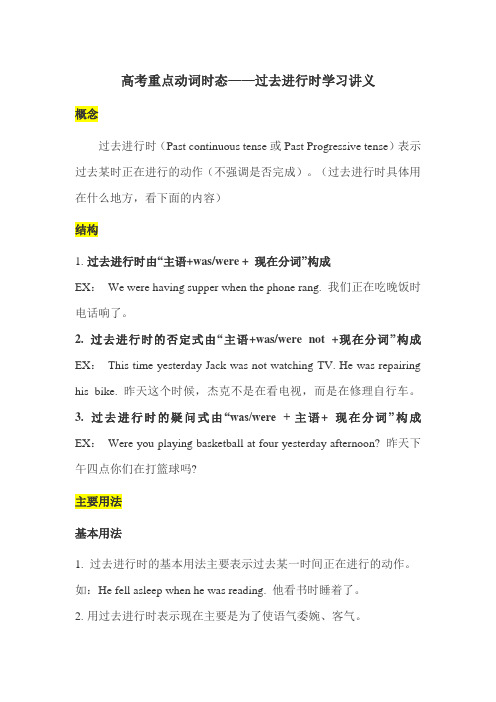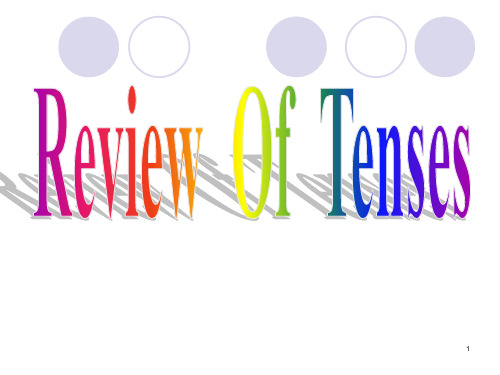现在,过去进行时讲义
英语过去进行时的详细讲义和习题

过去进行时一、过去进行时表示过去某一时刻或某段时间正在进行的动作。
构成:过去进行时态由助动词be的过去式was/ were+现在分词(doing)构成,第一人称和第三人称单数用was,其余的都用were。
二、过去进行时态的形式过去进行时的肯定式:I was working. / You were working. / He/She/It was working./ We/You/They were working.过去进行时的否定式:I was not working. / You were not working. / He/She/It was not working./ We / You / They were not working.过去进行时的疑问式:Were you working at ten last night? Yes, I was. / No, I wasn’t.Was he working at ten last night? Yes, he was. / No, he wasn’t.三、过去进行时态的用法1、它表示在过去某一时刻或某一时间内正在进行或发生的动作,通常和表示时间点的时间状语一起用。
如:My parents were watching TV at 8:00 last night.昨晚八点钟时我的父母亲都在看电视。
They were swimming in the swimming pool this time last week.上个星期的这个时候他们正在游泳池游泳。
2、在表示过去一个动作发生的时候,另一个动作同时也正在进行,那么持续时间长的动作要用过去进行时态。
经常和when引导的时间状语从句连用。
如:When the teacher came in, I was singing.老师进来时我正在唱歌。
When someone knocked at the door, we were having supper.有人敲门时,我们正在吃晚饭。
现在进行时和过去进行时课件(45张)

综合练习
结合实际语境运用现在进行时和过去进行时
学生需要在实际语境中运用现在进行时和过去进行时,例如描述正在进行的动作或状态,以及描述过 去某个时间正在进行的动作或状态。通过实际运用,学生可以更好地掌握现在进行时和ห้องสมุดไป่ตู้去进行时的 用法。
实际交流中如何选择合适的时态
02
现在进行时
现在进行时的定义
定义
现在进行时表示正在进行的动作 或存在的状态。它强调当前时间 点正在发生的事情。
例子
I am studying for the exam right now. (我正在为考试学习。 )
现在进行时的基本结构
基本结构
主语 + be动词(am/is/are)+ 副 词-ing + 宾语
例子
He is playing basketball. (他正在打 篮球。)
现在进行时的用法
用法一
表示当前正在进行的动作或状态。
01
用法二
表示即将发生的动作或状态,常与表 示将来的时间状语连用。
03
用法三
表示临时性、偶然性或一时的动作或状态。
05
02
例子
They are having dinner. (他们正在吃晚饭 。)
过去进行时是英语语法中的一种时态,表示在过去某一时刻或某一段时间内正 在进行的动作。这个时态通常用于描述过去某个时间点之前正在发生的动作或 状态。
过去进行时的基本结构
总结词
过去进行时的基本结构是由助动词“was”或“were”加上动词的现在分词构成 的。
《现在进行-过去进行时》PPT课件精选全文完整版

高二英语组
1
1.知识目标:a.能准确说出现在进行时和 过去进行时的概念、基本结构及相应句式
b.能准确记住现在分词的变化规律。 2.能力目标: a.能用进行时进行动作描述及 问答。 b.能够完成相应的进行时态的练习。
第一部分-现在进行时
现在进行时的概念 现在进行时的标志性词 现在进行时的句型变化
these days, while
例如: Look!Han Mei is singing there
!
Listen!Jack is talking.
What are you doing now?
It is running, now.
动词现在分词的构成规律
1) 一般情况下,在动词原形后直接加-ing. 如: work—working (工作) do—doing(做) play—playing(玩) 2) 以不发音的字母e结尾的动词,去掉e,再加ing. 如:
_I_s Cora_h_a_v_i_n_g_her dinner now? __Y_e__ , she ___is__. __sN_o___ , she __is_n_'_t___.
现在进行时的被动语态
读下列句子,并找出被动语态,总结被动语态的结构。 The problem is being discussed by students now. A new railway is being built in this city.
什么是现在进行时
现在进行时定义 (The Present Continuous Tense)
现在进行时表示现在或现阶段正在进行或发生的 动作,常和now,listen,look等词连用。
过去进行时讲课逐字稿

过去进行时讲课逐字稿课程名称:过去进行时教学目标:1. 学生能够理解过去进行时的概念和用法。
2. 学生能够通过例句掌握过去进行时的结构。
3. 学生能够在实际语境中正确使用过去进行时。
教学重点:1. 过去进行时的结构和用法。
2. 过去进行时与一般过去时的区别。
教学难点:1. 过去进行时与一般过去时的区分。
教学方法:1. 讲解法:通过解释和例句让学生理解过去进行时的概念。
2. 练习法:通过填空、改错等练习加深学生对过去进行时的理解。
3. 情景模拟:通过模拟实际情境让学生运用过去进行时。
教学过程:一、导入(5分钟)1. 通过提问学生昨天在做什么,引出过去进行时的概念。
2. 简要介绍过去进行时的定义:表示过去某一时刻或时间段正在进行的动作。
二、讲解(10分钟)1. 过去进行时的结构:主语+was/were+动词的现在分词。
2. 举例说明:- 我昨天正在看书。
(I was reading a book yesterday.)- 他们当时正在开会。
(They were having a meeting at that time.)三、对比分析(10分钟)1. 过去进行时与一般过去时的区别:- 过去进行时强调动作的进行状态,而一般过去时强调动作的完成。
- 例句对比:- 我昨天看了一本书。
(I read a book yesterday.)强调动作完成。
- 我昨天正在看书。
(I was reading a book yesterday.)强调动作进行。
四、练习(15分钟)1. 填空题:学生根据句子的语境填写正确的过去进行时形式。
2. 改错题:学生找出并改正句子中的过去进行时错误。
3. 连词成句:学生将给出的单词连成正确的过去进行时句子。
五、情景模拟(10分钟)1. 分组进行角色扮演,模拟过去某一时刻正在进行的活动。
2. 每组学生表演结束后,其他学生进行点评。
六、总结(5分钟)1. 回顾过去进行时的结构和用法。
现在进行时与过去进行时课件

第三部分:现在进行时与过去 进行时的对比与联系
课程安排
现在进行时与过去进行时的对比 现在进行时与过去进行时的联系
第四部分:练习与巩固
课程安排
词汇练习 口语表达练习
语法填空练习 写作练习
PART 02
现在进行时概述
现在进行时的定义
现在进行时定义为
表示现在或现阶段正在进行的动 作或状态。
结构
助动词be(am/is/are)+现在分 词(动词-ing形式)。
过去进行时的基本概念 过去进行时表示过去某一时刻正 在进行的动作或存在的状态,由 助动词be的过去时+动词的过去 分词构成。
过去进行时的疑问形式 将助动词be放在句首,缩略形式 为“were't”。
过去进行时的基本用法 描述过去某一时刻正在发生的动 作,强调过去的情境,常与表示 过去的连续时间状语如then、at that time等连用。
表示过去某个时间段内一直在进行的动作或存在的状态
01
02
03
04
肯定句
主语+was/were+动词 的现在分词+from...to...
否定句
主语+was/were+not+ 动词的现在分词 +from...to...
一般疑问句
Was/Were+主语+动词 的现在分词+from...to...
例句
过去进行时的否定形式 在助动词be的后面加上not,缩 略形式为“wasn't”。
THANKS
感谢观看
疑问词 + have/has + 主语 + been + 现 在分词 + 其他
现在进行时和过去进行时课件

本课程将帮助您学会现在进行时和过去进行时的基础知识和用法
现在进行时的定义和用法
定义
现在进行时是表示现在正在进行的动作或状态。
用法
主要用于描述正在进行的活动,通常和现在的时间状语连用。
示例
我正在看电影。
过去进行时的定义和用法
定义
表达过去某个时间正在进行的动作 或状态
用法
通常和表示“当时”“那时”“那天”等 过去的时间状语连用。
示例
昨天下午我在读一本小说。
现在进行时的构成和句型
1
构成
主语 + be动词(am/is/are) + 现在分词
2
肯定句
主语+ is/are +现在分词
3
否定句
主语+ is/are + not +现在分词
4
疑问句
倒装语序: Is/Are + 主语 + 现在分词 + …?
现在进行时 现在正在进行 be动词(am/is/are) + 现在分词 Is/Are + 主语 + Ving + …?
过去进行时 过去的某个时间正在进行 过去式be(was/were) + Ving Was/Were + 主语 + Ving + …?
现在进行时和过去进行时的常见错误
常见错误
混淆现在完成进行时和现在进行时
过去进行时的构成和 + Ving
否定句
主语+ was/were + not + Ving
肯定句
主语+ was/were + Ving
高考重点动词时态——过去进行时学习讲义

高考重点动词时态——过去进行时学习讲义概念过去进行时(Past continuous tense或Past Progressive tense)表示过去某时正在进行的动作(不强调是否完成)。
(过去进行时具体用在什么地方,看下面的内容)结构1.过去进行时由“主语+was/were + 现在分词”构成EX:We were having supper when the phone rang. 我们正在吃晚饭时电话响了。
2. 过去进行时的否定式由“主语+was/were not +现在分词”构成EX:This time yesterday Jack was not watching TV. He was repairing his bike. 昨天这个时候,杰克不是在看电视,而是在修理自行车。
3. 过去进行时的疑问式由“was/were +主语+ 现在分词”构成EX:Were you playing basketball at four yesterday afternoon? 昨天下午四点你们在打篮球吗?主要用法基本用法1. 过去进行时的基本用法主要表示过去某一时间正在进行的动作。
如:He fell asleep when he was reading. 他看书时睡着了。
2.用过去进行时表示现在主要是为了使语气委婉、客气。
如:I was wondering if you could give me a lift. 我不知你能否让我搭一下车。
【注】一般过去时也有类似用法,但比较而言,用过去进行时显得更客气,更不肯定。
3.过去进行时表示感情色彩与现在进行时相似,过去进行时也可表示满意、称赞、惊讶、厌恶等感情色彩,也通常与always,forever,continually等副词连用。
如:They were always quarreling. 他们老是吵架。
4.动词be的过去进行时也可表示过去一时的表现或暂时的状态。
中考复习-现在进行时和过去进行时全解课件(共11张PPT)

room.
A .Who
B .How C.What D.Where
3、 Don’t talk here. My mother _____.
A. is sleeping B .are sleeping C. sleeping D .sleep
4 、Danny ______. Don’t call him.
Were you cooking at that time? 那时,你在做饭吗? 现在进行时的用法: 其结构是助动词be的过去形式is/are/am +v-ing.
其句式变化仍然要在be上做文章。
现在(说话的瞬间)正在进行或发生的动作,强调“此时此刻”。E.g. He is reading . They are talking now.
典型例题
1) Mary ___ a dress when she cut her finger.
A. made B. is making C. was making D. makes 答案C. 割伤手指是已发生的事情,应用过去时。同 时,when表时间的同时性,"
玛丽在做衣服时"提供事情发生的背景,因此用过去进行时。
不用进行时的动词 1) 事实状态的动词
have, belong, possess, cost, owe, exist, include, contain, matter, weigh, measure, continue
I have two brothers. This house belongs to my sister. 2) 心理状态的动词 Know, realize, think see, believe, suppose, imagine, agree, recognize, remember, want, need, forget, prefer, mean, understand, love, hate I need your help. He loves her very much. 3 ) 瞬间动词 accept, receive, complete, finish, give, allow, decide, refuse. I accept your advice. 4) 系动词 seem, remain, lie, see, hear, smell, feel, taste, get, become, turn You seem a little tired.
现在过去进行时ppt课件

现在过去进行时的用法
表示过去某个时间正在进行的动作
使用现在过去进行时可以表示在过去某个时间点正在进行 的动作,强调动作的持续性。
例子
She was cooking dinner when I called her.(我打电话 给她的时候,她正在做饭。)
表示过去某个时间段内的行为
使用现在过去进行时可以表示在过去某个时间段内持续进 行的动作或状态。
与when引导的时间状语从句连用
总结词
表示某个时间点正在进行的动作
详细描述
当when引导的时间状语从句表示某个时间点时,主句可以使用现在过去进行时 ,表示在这个时间点上正在进行的动作。例如,“When he was having dinner, the phone rang.”(当他正在吃饭时,电话响了。)
04
现在过去进行时的练习与 巩固
选择题练习
选择题1
He _______ a book when I came in.
选择题2
They _______ football when the rain started.
选择题3
What were you doing when the phone rang?
与while引导的时间状语从句连用
总结词
表示两个动作同时发生
VS
详细描述
当while引导的时间状语从句表示两个动 作同时发生时,主句可以使用现在过去进 行时,强调两个动作的同步性。例如, “While he was watching TV, his wife called him.”(当他正在看电视时,他的 妻子给他打了电话。)
现在过去进行时ppt课件
目录
• 什么是现在过去进行时 • 现在过去进行时的基本用法 • 现在过去进行时的特殊用法 • 现在过去进行时的练习与巩固 • 现在过去进行时的注意事项
高考英语语法:现在进行时讲义

高中英语语法:现在进行时基本概念及巩固练习过去进行时基本概念具体概念一、概念和用法:过去进行时表示在过去某一时刻或某一段时间内进行或发生的动作.其形式为was /were + V-ing.常与表示过去的时间状语连用,如:last night,last Saturday等;或者与when,while,as引导的过去时间状语连用.如:We were watching TV from seven to nine last night. 昨天晚上七点到九点的时候我们在看电视.What was he researching all day last Sunday? 上周日他一整天都在研究什么?二、过去进行时可以表示在过去某个时间点发生的事情.时间点可以用介词短语、副词或从句来表示.如:What was she doing at nine o‘clock yesterday? 昨天晚上九点她在做什么? (介词短语表示时间点)When I saw him he was decorating his room. 当我看见他的时候他正在装饰房间.(when从句表示时间点)三、在复合句中,如果主要动作和背景动作都是延续的或同时发生的,那么主从句的动词都可用过去进行时.如:While he was waiting for the bus,he was reading a newspaper.他边等车边看报.(两个动作都是延续的)He was cleaning his car while I was cooking. 他擦车时我在做饭.(两个动作同时进行)四、通常不能用于过去进行时的动词主要有:agree,is,am,are,believe,belong,care,forget,hate,have(有),hear,know,like,love,mean,mind,notice,own,remember,se em,suppose,understand,want,wish等.如:误:I was knowing the answer.正:I knew the answer. 我知道答案.误:I wasn‘t understanding him.正:I didn‘t understand him. 我不明白他的意思.结构组成编辑1. 过去进行时由“主语+was/were + 动词ing”构成如: We were having supper when the phone rang. 我们正在吃晚饭时电话响了.2. 过去进行时的否定式由“主语+was/were not +现在分词”构成如: This time yesterday Jack was not watching TV. He was repairing his bike. 昨天这个时候,杰克不是在看电视,而是在修理自行车.3. 过去进行时的疑问式由“was/were +主语+ 现在分词”组成如: Were you playing basketball at four yesterday afternoon? 昨天下午四点你们在打篮球吗?句型肯定句:主语+was/were+doing+其它否定句:主语+was/were+not+doing+其它一般疑问句:问语=Was/Were+主语+doing+其它答语:Yes,I was/were.或No,I wasn't/weren’t.特殊疑问句:特殊疑问词+一般疑问句+其它例句1、We were having supper when the phone rang. 我们正在吃晚饭时,电话响了。2、This time yesterday Jack was not watching TV. 昨天这个时候杰克不在看电视.3、He was repairing his bike.他在修理自行车.4、When/While we were having supper, the light went out. 我们正在吃饭时,灯熄灭了.5、While we were talking, the teacher came in. 当我们正在谈话时,老师进来了.6、While he was waiting for the bus, he was reading anewspaper.他边等车边看报.7、He was cleaning his car while I was cooking. 他擦车时,我正在做饭.8、Tom was getting up at six o’clock every day that week. 汤姆那一周里每天都是六点钟起床.过去进行时的误区提醒过去进行时与一般过去时的区分,可能是同学们头疼的地方。
现在过去进行时课件

ONE
KEEP VIEW
现在过去进行时课件
REPORTING
CATALOGUE
目 录
• 现在过去进行时的定义 • 现在过去进行时的构成 • 现在过去进行时的句型 • 现在过去进行时的用法 • 现在过去进行时的比较 • 现在过去进行时的练习
PART 01
现在过去达的是一种回忆、感慨 的情感,而现在过去进行时则表达的 是一种怀旧、感慨的情感。
语境不同
过去进行时强调过去的某个时间段内 发生的动作,而现在过去进行时则强 调过去的某个时间点上发生的动作。
与将来进行时的比较
1 2 3
时间点不同
将来进行时表示将来某一时刻正在进行的动作, 而现在过去进行时则表示过去某一时刻正在进行 的动作。
的持续性。
详细描述
例如,“上个星期我在学习编程 ”,这句话就表示在上个星期这 个时间段内,我正在进行学习编
程这个动作。
示例
I was learning to program last week.
表示过去某个时间点正在进行的动作
总结词
这个时态可以用来描述过去某个确切的时间点发生的动作,强调 动作的精确性。
语境不同
将来进行时强调将来的某个时刻正在发生的动作 ,而现在过去进行时则强调过去的某个时间点上 发生的动作。
表达情感不同
将来进行时表达的是一种期待、憧憬的情感,而 现在过去进行时则表达的是一种怀旧、感慨的情 感。
PART 06
现在过去进行时的练习
单项练习
填空练习
给出句子,让学生填写正 确的现在过去进行时态的 动词形式。
作的持续性。
详细描述
例如,“昨天下午三点我正在写论 文”,这句话就表示在昨天下午三 点这个时间点,我正在进行写论文 这个动作。
经典:现在进行时和过去进行时课件

1.意义:表示在过去某一时刻或一段时
间正在进行的动作。
2.构成: was/were +doing
否定式: was/were not +doing
疑问式:Was/Were ……doing? 3.标志词: at this time yesterday at 9:00 last night
……was/were doing when….did…..
四.现在进行时的形式转换:
1.将一个现在进行时的肯定句变为一般疑问句时,将句 中的be动词提到句首。
Eg: He is talking to his teacher.
Is he talking to his teacher?
I am singing.--------- Are you singing? 2.将现在进行时的肯定句变为否定句时,在be动词后 面加上not.
(6 )He is very busy . He is writing a letter .(write) (7)Don’t speak! My father is sleeping .(sleep)
(8) It’s twelve o’clock. The studentsare having (have)
现在进行时和过 去进行时
Present Continuous Tense and the past Continuous Tense
马海霞
She is readw.
Listen! The bird is singing.
Look! The boy is playing football.
am/is/are 在现在进行时句子谓语结 构中作助动词用,无词义。am/is/are的 选择运用由句子的主语人称或数决定。
现在进行时 过去进行时PPT课件

29
yesterday afternoon
have a class
30
at five o’clock play football
…
31
play basketball when the teacher came in
32
read a book yesterday afternoon
36
4) The children _w_e_r_e _p_la_y_in_g_(play) football at four yesterday afternoon. 5) The baby _w_a_s_s_le_e_p_in_g_ (sleep) when the mother came back. 二. 完成下列句子 1)Li Leiw_a_s_r_e_a_d_in_g (在读英语)at this time yesterday.
21
1、我的妈妈正在做早饭。
My mother is making breakfast. 2、我正要和我的朋友去看电影。
I am going to movies with my friend. 3、他正在弹吉他吗?
Is he playing the guitar? 4、她不在拉小提琴。
She isn’t playing the violin. 5、她们在干什么?正在打篮球。
7
---Is the woman writing? ----No, she isn’t. She is reading a book8.
----What’re they doing?
----They’re swimming.
----Are they swimming?
- 1、下载文档前请自行甄别文档内容的完整性,平台不提供额外的编辑、内容补充、找答案等附加服务。
- 2、"仅部分预览"的文档,不可在线预览部分如存在完整性等问题,可反馈申请退款(可完整预览的文档不适用该条件!)。
- 3、如文档侵犯您的权益,请联系客服反馈,我们会尽快为您处理(人工客服工作时间:9:00-18:30)。
现在,过去进行时讲义动词时态讲义(三)现在进行时:表示现在的某一时刻或现阶段内正在发生或进行的动作或存在的状态。
例:1)I am studying in Chang Jiang Middle School now.2)The students are having lunch at school.3)We are working hard.4)They are singing an English song happily.(一)现在进行时的构成现在进行时的句子构成:“主语﹢助动词be (am, is, are) ﹢现在分词(v.﹣ing)”。
动词的现在分词是由动词加-ing构成。
动词的现在分词的构成有以下规则:1.一般在动词后直接加-ing例:work—working study—studying drink—drinking stay—staying ask—asking see—seeing kick—kicking send—sending look—looking cry—crying call—calling jump—jumping2.若动词是以不发音的e结尾,则要去e加-ing.例:give—giving live—living have—having write—writing ride—riding take—taking close—closing operate—operating translate—translating 3.以一个元音字母加一个辅音字母结尾的重读闭音节动词,要先双写最后的辅音字母再加-ing.例:sit—sitting shop—shopping run—running swim—swimming cut—cutting drop—dropping begin—beginning put—putting4.以ie结尾的动词,若ie所在的音节是重读音节,则要把ie变为y再加-ing. 例:tie—tying lei—lying die—dying5.以er结尾的动词,若er所在的音节是重读音节,则要先双写r 再加-ing, 若er所在的音节是非重读音节,则直接在其后加-ing.例:refer—referring prefer—preferring water—watering wonder—wondering (二)现在进行时的句式转换现在进行时的句子中有助动词be (am/ is/ are ).因此变成疑问句时应把be动词提到主语前,变成否定句时在be动词后加否定词not.例:Jack is wearing a red jacket and a pair of blue jeans.→Is Jack wearing a red jacket and a pair of bl ue jeans?Yes, he is. / No, he isn’t.→Jack isn’t wearing a red jacket and a pair of blue jeans.→What is Jack wearing?(三)现在进行时的用法1.表示说话时正在进行的动作,通常与now, look, listen, at the moment等词连用。
例:Look! The students are skating happily on the ice.What are the dogs barking at?Listen! Your mother is calling you.Please wait for a while. I’m doing my homework at this moment.Look! It’s raining heavily. You should take your rain coat.We are watching TV now.John is playing the piano.Are you waiting for me now?2.表示现在一段时间内正在进行着的动作或所处的状态,常与these days(这几天),all the time/ at present(目前),this week (本周),this month (本月)等时间词连用。
例:We are learning Lesson Eight this week.The young man is teaching at school these years.The boys are running and singing all the time.I am worrying about you these days.We are making model planes this month.3. 现在进行时可以表示经常反复的动作,常与always, continuously等频度副词连用,突出表现喜欢、赞扬或厌恶的感情色彩。
例:He is always asking me the same questions.He is always doing everything very carefully.Mom is continuously blaming me.My God! I am always losing my pen.4. 现在进行时还可以用来表示发展变化中的情况或状态。
例:The day is getting longer and longer and the night is getting shorter and shorter in spring.The lady is getting older and older. She is very sad because of it.The hole is getting bigger and bigger.5. 一些常见的表示具体行为的动词(如come / go / leave / start / do / arrive / reach / stay / have / hold / catch / buy等)用于进行时态时可能表示按照安排将要发生的动词或状态。
例:The headmaster is leaving here for Australia soon.Are you buying this tie?Where are you going tomorrow?Stop talking! The teacher is coming.They are having a meeting this afternoon.The film is starting in a few minutes.6.若主句是一般将来时态,其条件、时间状语从句有时可以用现在进行时态表示将来正在进行的动作。
Mom will prepare food while I am doing my homework.If she is still having class, I won’t c all him.(四)一般不用进行时态的动词1、一些表示心理情感的动词或状态的动词一般不用进行时态。
如: love, like, know, understand, forget, remember, believe, think, want, mind, wish, need, agree, hate, prefer, wonder, suppose, hope, doubt, seem, have, belong to, own, stay,remain, lie等。
如:I love my school.I wish you a merry Christmas.I prefer swimming to skating.Japan lies to the east of China.He seems rather angry with you.I still remember the days when we studied together.I am happy.He's tired.It's hot today但是,如果以上动词用了现在进行时态,则表现出说话人很有礼貌,带有较强的感情色彩。
如:She is hoping to see you soon.I am wondering if you can come to meet me and play together.2、表示感觉的动词:see, hear, smell, taste, feel,sound,notice等。
The apples taste good. 这些苹果尝起来不错。
This flower smells nice. 这花闻上去很香。
Your suggestion sounds reasonable. 你的建议听上去有道理。
注意:如果这些动词表示一种有意识的行为,则可用进行时态。
She is tasting the apple. 她正在尝苹果。
The dog is smelling the footprints. 狗正在嗅脚印。
3.表示一次性动作的动词没有进行时态如decide,receive,allow,give, accept, promise等。
We decide to form a school football team.My parents promised to send me to the best university.(五)现在进行时的被动语态现在进行时的被动语态的结构是:主语+ am / is/ are + being+动词的过去分词+ 其他例:His house is being painted white.A new bridge is being built over the river.They are being asked by the policeman.动词时态讲义(四)过去进行时:过去进行时表示在过去的某一时刻或某段时间内正在发生或进行的动作或存在的状态。
When you phoned yesterday, I was playing computer chess.We are working from two to four yesterday afternoon.(一)过去进行时的构成主语﹢助动词be (was\were) ﹢现在分词(v.﹣ing)例如:I was doing my homework at 8:00 last night.It was raining heavily when we left the school.(二)过去进行时的句式转换过去进行时中也有助动词be(am\is\are),因此变成疑问句时应把be动词提到主语前,变成否定句时在be动词后加not.例:They were talking noisily in the classroom when the teacher came in.→They weren’t talking noisily in the classroom when the teacher came in.→Were they talking noisily in the classroom when the teacher came in?(三)过去进行时的用法过去进行时主要用来表示在过去的某段时间内正在发生或进行的动作或存在的状态,特别强调动作的正在进行,常用于以下情况:1、表示在过去的某一时刻正在进行的动作,一般要和过去特定的时间状语(如:at that time, at this time yesterday\last week\ last month…, at 8:00 yesterday等)或由when, while, as等词引导的时间状语从句连用。
